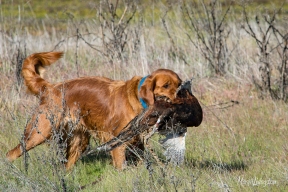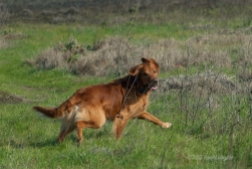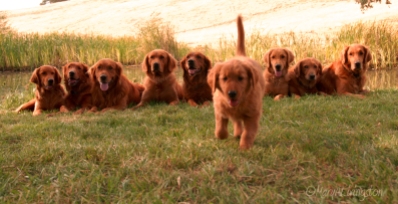In celebration of National Dog Day…

Phanny photobombs!

Sitting pretty.

Pure joy, she is such a happy puppy!

A beautiful day in the frying-pan poppies for the puppy in the mandarine spice collar.

Strolling through the grass.

Hope your day is ducky!

Bliss and Phanny photobombed a puppy photo shoot.

Here, have a smile!

Tasha’s puppies are due any day!

The entire pack when we returned home. Tasha is on maternity leave so she wasn’t at the club with us. She enjoyed the birds once we got home.

Bliss pointing her pheasant.

Sailor pointing his pheasant.

Phanny’s first retrieve of the day lands in the water.

Phanny flushes a beautiful rooster.

Sailor bringing dinner in.

A nice wrap to a day at Clear Creek Sports Club.

Bliss bringing in her bounty.

Bliss with a nice rooster.

Sailor shows his appreciation.

Phanny relishes her pheasant.

Phanny gets another water retrieve.

Saturday Night Redtail Phantom

Phanny on her first hunting retrieve.

Phanny delivers her pheasant to Tim.

The three of us.

Sailor’s tie-breaking jump gains another foot in distance.

Sailor’s second jump ties him with Bliss.

Fluffy puppy Phanny builds confidence in her jumps before taking on the full run.

Bliss’ 1st jump of the night.

Tasha takes her leap from the side. Happy girl.

Bliss and Tim on her 2nd jump

Wait for me!

We stopped at the Gallatin River for a family shot on our way to the west side of Yellowstone while heading home.

Bliss plans a twig thieving strike.

About half way home near the border between Idaho and Nevada, Tim snapped this shot of me with Phanny.

Phanny knocked the food bag over and helped herself.

Tasha, Sailor, and Bliss by the creek the day before we left with Phanny.

Tasha slips into the pond in an attempt to escape the pesky puppy.

Phanny meets the chickens. Later she will learn these are “no birds.”

Phanny in the blue lupin.

The first shot of the pack at home. L-R: Bliss, Tasha, Phanny, Sailor

Better grab fast.

On it!

Enjoying the moment. A good start for a future hunter.

Proud puppy success.

A natural born swimmer.

Phanny sneaks a moment with Tim.

The nice cool water felt pretty good.

Wait for me. Phanny follows the big dogs into the little pond.

Saturday Night Redtail Phantom – “Phanny”

Bliss, Sailor, Tasha and Phanny in front.

In our area, the first showing of wild flowers happens around Tasha’s birthday.

Tasha is joined by Sailor and Bliss. Bliss, Sailor, Tasha

Redtail’s Hotty Toddy Tasha – turns 3 years old today.

Everyone needs a hug now and then. Tasha and one of her 2-day-old puppies. Too cute.

Sometimes life requires a different approach.

Finally, all together at camp.

Hope. We have hope that she will make it.

Bliss and her great-granddam, Chloe. Two peas in a pod.

Great-granddam, Blaze, at 2-years-old.

Lacey, great-great-grandam. Photo-courtesy Kathleen Hagen

Great-great-granddam, Blaze, at 7-weeks-old.

1989 – Great-great-great-Granddam, Kate, 6-months-old, after a pheasant hunt with Bo. (great-great-great-grandsire)

Gracie and Sailor watch ducks on the big pond.

Sailor in a late winter sunset with ducks on the pond at our place.

A nice shot of Blitz (front) with Kinta and Sailor in a patch of frying-pan poppies.

Sailor wraps up his first pheasant season.

One year later.

Sailor enjoys a visit from Bella.

Sailor

His favorite hangout is at our ponds with the ducks.

Sailor has a happy disposition.

Hunting with Sailor.

Hard charging drive.

Sailor on the hunt. Yes, he’s always this happy.

The sun filters in on Sailor in the Redwoods.

On the beach near Smith River. CA. L-R: Kinta, Tim, Mary, Sailor

Sailor has lots of energy and loves the water.

All go…

I can’t believe this week marks six months since Sailor came into our home. He blossoms a little more each day.

Young Kinta is almost 11 months old. Next month, he goes home to his forever home with his family in Japan.

Kinta’s second land retrieve.

Success! Kinta earns his first JH qualifier. L-R: Noriko, Mary, Tim – Kinta with his ribbon.

Kinta crosses water, land, water, land, water, and finally land for the final bird. A difficult retrieve for a young dog,

Bringing it in with smile.

The impish look comes right before the paper shred. Don’t worry Rhythm, the book was saved in the nick of time!

Saturday Night Kintaro of Akiyama – Kinta helps me haul firewood.

Handsome boy watches down the driveway… are those quail he sees?

Kinta enjoys some Northern California sunshine.

Noriko and Yoshi with the pack.

Noriko, Sakurako, Mary & Hawk

Hawk and Saku with Noriko and Mary

People: Noriko, Yoshinori, Mary, Tim Goldens: Jutaro, Hawk, Blitz, Tessa, Tom, Nellie

Tim, The Forester Artist, with Blitz and Teka.

Teka greets Kathleen, one of her people who came to watch her at the event. Teka properly loved up both Doug and Kathleen.

Puppies serve as a perfect distraction to capture her beautiful smile. Along with our grand-daughter, she enjoys the pups. The one she is petting will grow up to be the sire to her dog.

Tom dog (R) walks with Grandthing 3 and Jake (L) Jake is Tom dog’s grand-pup.

Tom dog came home to a young 11 year old boy. Now 26, Tom’s “boy” misses him the most.

Stephen and Tom with Tim and Blaze following successful Senior Hunter Qualifiers.

Tessa all ready for a visit. She was an active participant in Rx Pets.
http://www.prescriptionpets.org/ She often carried a basket of fun while cheering people.

This photo was taken a few weeks before she died in this last spring. Today is the first birthday without her. Many lives were touched by this wonderful girl.

Taken at 7½ weeks. Hawk was a very special dog.

Sneaking a little bliss with Tim’s pens… shhh, he doesn’t know 🙂




















































































































































